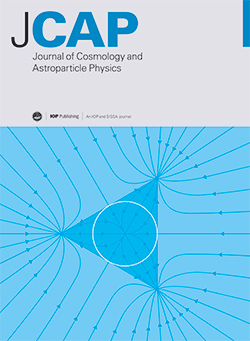根据目前和即将进行的星系巡天探索中微子相互作用
IF 5.3
2区 物理与天体物理
Q1 ASTRONOMY & ASTROPHYSICS
Journal of Cosmology and Astroparticle Physics
Pub Date : 2025-03-21
DOI:10.1088/1475-7516/2025/03/047
引用次数: 0
摘要
本文章由计算机程序翻译,如有差异,请以英文原文为准。
Exploring neutrino interactions in light of present and upcoming galaxy surveys
In the standard cosmological framework, neutrinos begin to free-stream after the weak interaction phase ends in the early universe, at a temperature of approximately T ∼ 1 MeV. However, the onset of neutrino free-streaming can be delayed if additional interactions occur in the early universe, leaving imprints on both the cosmic microwave background (CMB) angular power spectra and the large-scale structure (LSS) matter power spectra. We present a thorough analysis of early universe neutrino interactions with a fairly generalized parameterization of the interaction rates as a power law in neutrino temperature. In this (6+2) parameter scenario, we constrain the cosmological parameters along with the free-streaming redshift and the sum of the neutrino mass in presence of such interactions, with the help of full shape (FS) galaxy power spectra from BOSS Data Release 12. Our analysis reveals that a combined dataset of FS along with CMB and BAO offers improved constraints on the free-streaming redshift from present data, comparable to the forecast results from future CMB-S4 data. Additionally, we investigate the prospects of future galaxy surveys by forecasting on Euclid mission in combination with Planck and CMB-S4, and find significant improvement on both the free-streaming redshift and the sum of the neutrino mass than the existing constraints as well as than CMB-S4 alone.
求助全文
通过发布文献求助,成功后即可免费获取论文全文。
去求助
来源期刊

Journal of Cosmology and Astroparticle Physics
地学天文-天文与天体物理
CiteScore
10.20
自引率
23.40%
发文量
632
审稿时长
1 months
期刊介绍:
Journal of Cosmology and Astroparticle Physics (JCAP) encompasses theoretical, observational and experimental areas as well as computation and simulation. The journal covers the latest developments in the theory of all fundamental interactions and their cosmological implications (e.g. M-theory and cosmology, brane cosmology). JCAP''s coverage also includes topics such as formation, dynamics and clustering of galaxies, pre-galactic star formation, x-ray astronomy, radio astronomy, gravitational lensing, active galactic nuclei, intergalactic and interstellar matter.
 求助内容:
求助内容: 应助结果提醒方式:
应助结果提醒方式:


